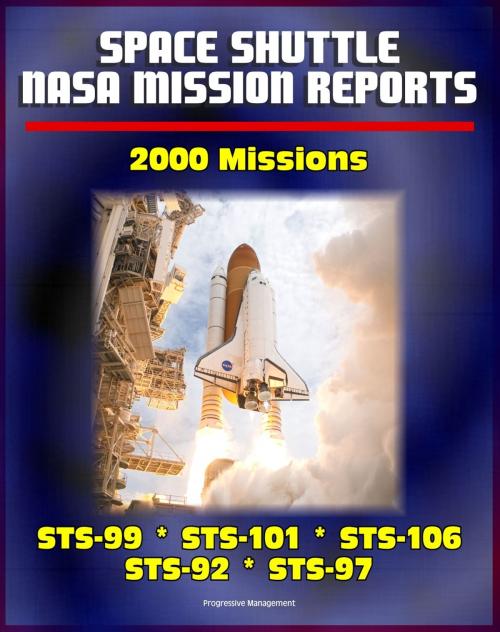Space Shuttle NASA Mission Reports: 2000 Missions, STS-99, STS-101, STS-106, STS-92, STS-97
Nonfiction, Science & Nature, Science, Physics, Astrophysics & Space Science| Author: | Progressive Management | ISBN: | 9781465836540 |
| Publisher: | Progressive Management | Publication: | February 21, 2012 |
| Imprint: | Smashwords Edition | Language: | English |
| Author: | Progressive Management |
| ISBN: | 9781465836540 |
| Publisher: | Progressive Management |
| Publication: | February 21, 2012 |
| Imprint: | Smashwords Edition |
| Language: | English |
These official final program mission reports issued by the NASA Johnson Space Center cover missions in 2000: STS-99, STS-101, STS-106, STS-92, STS-97. In these thorough reports, with information and specifics not available on NASA website mission descriptions, each orbiter system is reviewed in detail along with technical information on performance and anomalies.
STS-99: The Space Transportation System (STS) -99 flight was the only planned flight of the Shuttle Radar Topography Mission (SRTM), which acquired high-resolution radar topographic images of the Earth's land mass between 60 °N and 56 °S latitude. The data from this mission will be used to produce a land map that is 30 times more precise than any map in existence prior to the mission.
STS-101: The primary objectives of the STS-101 flight were to provide the ISS Program with logistics capability for transfer and internal/external installation and checkout of ISS hardware, specifically the Orbiting ISS Stage 2A.1, utilizing a double Spacehab module, Integrated Cargo Carrier (ICC) and Orbiter crew compartment. Prior to undocking, one scheduled extravehicular activity (EVA) was performed for external equipment transfer. In addition, the secondary objectives of this flight were to perform the requirements for Space Experiment Module (SEM-06), Mission to America's Remarkable Schools (MARS), Commercial Protein Crystal Growth (CPCG), Protein Crystal Growth-Biotechnology Ambient Generic (PCG-BAG), BioTube Precursor Experiment (BioTube), Astroculture (AST).
STS-106: The primary objectives of the STS-106 flight were to change the Zvezda [Service Module (SM)] from the launch to the flight configuration by installing six ground repressurization inlet caps, removing the fire extinguisher launch restraint bolts and activating the gas masks in the module for the Expedition 1 crew. In addition, the crew performed various logistics activities, which included unloading the Progress cargo vessel into the ISS and transferring equipment, supplies and water from the Space Shuttle to the ISS. The TORU docking unit and the aft docking probe were removed from the Zarya [Functional Cargo Block (FGB)] module. The crew replaced two batteries on the FGB, installed three batteries and associated electronic equipment on the SM, installed voltage converters in the SM and performed other electrical work in the SM. A spacewalk was performed to connect power, data and communication cables between the SM and the FGB, as well as install a magnetometer.
STS-92: The primary objective of the STS-92 flight was to launch, rendezvous and dock with the orbiting ISS stage and deliver to orbit the 3A launch package (LP). The Z1 Integrated Truss Segment (ITS) was attached to the zenith port of Node 1. In addition, the Pressurized Mating Adapter 3 (PMA 3), which was launched on a Spacelab Logistics Pallet (SLP) carrier, was attached to the nadir port of Node 1. Additionally, two extravehicular activity (EVA) tool stowage devices (ETSDs) that were launched on the SLP, and two DC to DC converter units (DDCUs) that were launched on the Get-Away Special (GAS) Beam carriers, were installed on the Z1 truss on-orbit via EVA. Several other EVA tasks, as well as Node 1 ingress, were accomplished during the flight.
STS-97: The primary objective of the STS-97 flight was to deliver and assemble the 4A launch package (LP) to the orbiting ISS Stage 3A.
These official final program mission reports issued by the NASA Johnson Space Center cover missions in 2000: STS-99, STS-101, STS-106, STS-92, STS-97. In these thorough reports, with information and specifics not available on NASA website mission descriptions, each orbiter system is reviewed in detail along with technical information on performance and anomalies.
STS-99: The Space Transportation System (STS) -99 flight was the only planned flight of the Shuttle Radar Topography Mission (SRTM), which acquired high-resolution radar topographic images of the Earth's land mass between 60 °N and 56 °S latitude. The data from this mission will be used to produce a land map that is 30 times more precise than any map in existence prior to the mission.
STS-101: The primary objectives of the STS-101 flight were to provide the ISS Program with logistics capability for transfer and internal/external installation and checkout of ISS hardware, specifically the Orbiting ISS Stage 2A.1, utilizing a double Spacehab module, Integrated Cargo Carrier (ICC) and Orbiter crew compartment. Prior to undocking, one scheduled extravehicular activity (EVA) was performed for external equipment transfer. In addition, the secondary objectives of this flight were to perform the requirements for Space Experiment Module (SEM-06), Mission to America's Remarkable Schools (MARS), Commercial Protein Crystal Growth (CPCG), Protein Crystal Growth-Biotechnology Ambient Generic (PCG-BAG), BioTube Precursor Experiment (BioTube), Astroculture (AST).
STS-106: The primary objectives of the STS-106 flight were to change the Zvezda [Service Module (SM)] from the launch to the flight configuration by installing six ground repressurization inlet caps, removing the fire extinguisher launch restraint bolts and activating the gas masks in the module for the Expedition 1 crew. In addition, the crew performed various logistics activities, which included unloading the Progress cargo vessel into the ISS and transferring equipment, supplies and water from the Space Shuttle to the ISS. The TORU docking unit and the aft docking probe were removed from the Zarya [Functional Cargo Block (FGB)] module. The crew replaced two batteries on the FGB, installed three batteries and associated electronic equipment on the SM, installed voltage converters in the SM and performed other electrical work in the SM. A spacewalk was performed to connect power, data and communication cables between the SM and the FGB, as well as install a magnetometer.
STS-92: The primary objective of the STS-92 flight was to launch, rendezvous and dock with the orbiting ISS stage and deliver to orbit the 3A launch package (LP). The Z1 Integrated Truss Segment (ITS) was attached to the zenith port of Node 1. In addition, the Pressurized Mating Adapter 3 (PMA 3), which was launched on a Spacelab Logistics Pallet (SLP) carrier, was attached to the nadir port of Node 1. Additionally, two extravehicular activity (EVA) tool stowage devices (ETSDs) that were launched on the SLP, and two DC to DC converter units (DDCUs) that were launched on the Get-Away Special (GAS) Beam carriers, were installed on the Z1 truss on-orbit via EVA. Several other EVA tasks, as well as Node 1 ingress, were accomplished during the flight.
STS-97: The primary objective of the STS-97 flight was to deliver and assemble the 4A launch package (LP) to the orbiting ISS Stage 3A.















